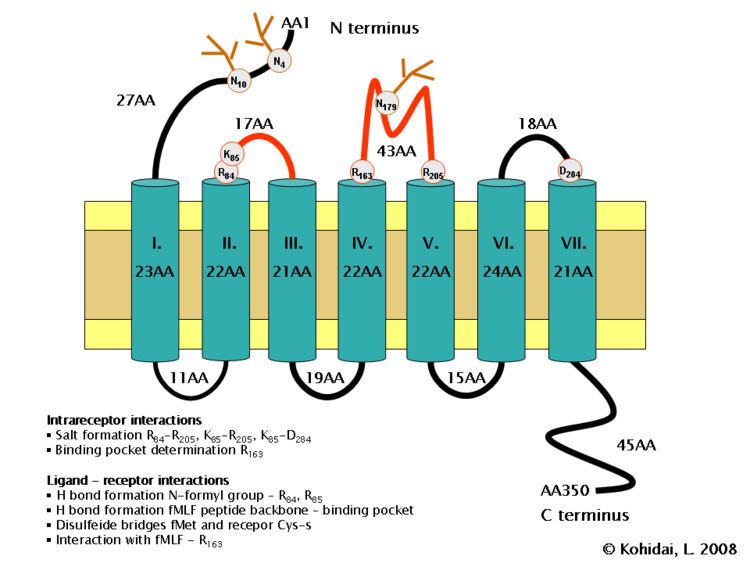Symbol FPR1 Entrez 2357 OMIM 136537 | Alt. symbols FPR; FMLP HUGO 3826 RefSeq NM_002029 | |
 | ||
The formyl peptide receptors (FPR) belong to a class of G protein-coupled receptors involved in chemotaxis. In humans, there are three formyl peptide receptor isoforms, each encoded a separate gene that are named FPR1, FPR2, and FPR3. These receptors were originally identified by their ability to bind N-formyl peptides such as N-formylmethionine produced by the degradation of either bacterial or host cells. Hence formyl peptide receptors are involved in mediating immune cell response to infection. These receptors may also act to suppress the immune system under certain conditions. The close phylogenetical relation of signaling in chemotaxis and olfaction was recently proved by detection formyl peptide receptor like proteins as a distinct family of vomeronasal organ chemosensors in mice
Contents
FPR is now properly accepted as termed FPR1 by the International Union of Basic and Clinical Pharmacology.
Discovery
Studies conducted in the 1970s found that a series of N-Formylmethionine-containing oligopeptides, including the most potent and best known member of this series, N-formyl-methionyl-leucyl-phenylalanine (FMLP or fMet-Leu-Phe), stimulated rabbit and human neutrophils by an apparent receptor-dependent mechanism to migrate in a directional pattern in classical laboratory assays of chemotaxis. Since these oligopeptides were produced by bacteria or synthetic analogs of such products, it was suggested that the N-formyl oligopeptides are important chemotatic factors and their receptors are important chemotactic factor receptors that act respectively as signaling and signal-recognizing elements to initiate Inflammation responses in order to defend against bacterial invasion. Further studies defined a receptor for the N-formyl oligopeptides, formyl peptide receptor (FPR), so named based on its ability to bind and become activated by the oligopeptides. Two receptors where thereafter discovered and named FPR1 and FPR2 based on the similarity of their genes' predicted amino acid sequence to that of FPR rather than on any ability to bind or be activated by the formyl oligopeptides. These three receptors have been renamed as FPR1, FPR2, and FPR3 and found to have very different specificities for the formyl oligopeptides and very different functions that include initiating inflammatory responses to N-formyl peptides released not only by bacteria but also a multiplicity of elements released by host tissues; dampening and resolving inflammatory responses; and perhaps contributing to the development of certain neurological cancers and an array of neurological diseases Amyloid-based diseases.
Structure and function
The formyl peptide receptor (FPR) belongs to the class of receptors possessing seven hydrophobic transmembrane domains. The conformation of the FPR is stabilized by several interactions. These include potential salt bridge formation between Arg84-Arg205, Lys85-Arg205, and Lys85-Asp284 which help determine the three-dimensional structure of transmembrane domains, as well as positively charged residues (Arg, Lys) which interact with negatively charged phosphates. Furthermore, residue Arg163 may interact with the ligand binding pocket of the second extracellular loop of the FPR.
With respect to binding of the formyl Met-Leu-Phe peptide, there are additional potential interactions which include hydrogen bonding interactions between Arg84 and Lys85 of the first extracellular loop and the N-formyl group of the ligand as well as the peptide backbone of formyl Met-Leu-Phe which can form similar interactions. The formyl-Met moiety of the ligand was shown to form disulfide bridges with Cys residues, and an interaction with Arg163 was also demonstrated. (It is important to mention that some interaction which stabilize the conformation of the receptor may also influence ligand-binding.) Some oligopeptides were also described as characteristic constituents linked to Asn-s of the extracellular N terminal part and to the ligand binding pocket of the second extracellular loop. These components can also determine or make more specific the ligand-receptor interaction.
Signaling pathways
Induction of FPR triggers multiple changes in eukaryotic cells including rearrangement of the cytoskeleton which in turn facilitates cell migration and the synthesis of chemokines. Important FPR regulated pathways include:
